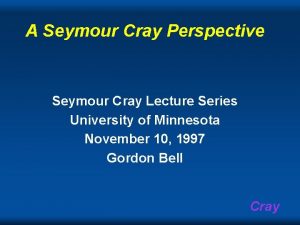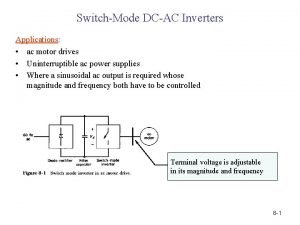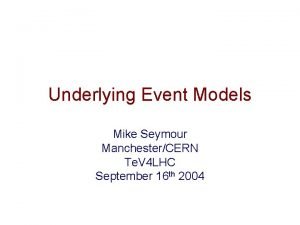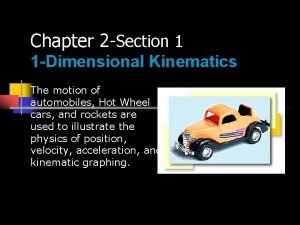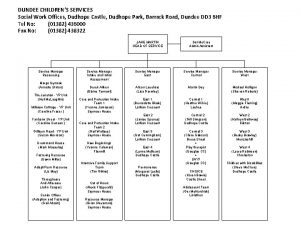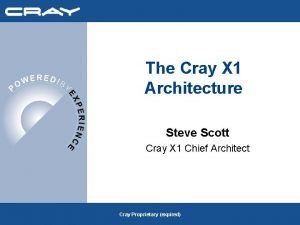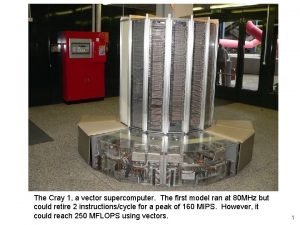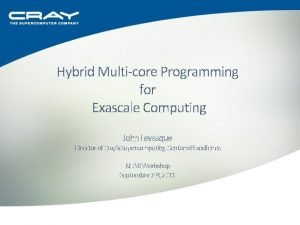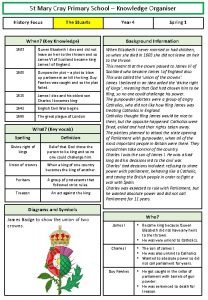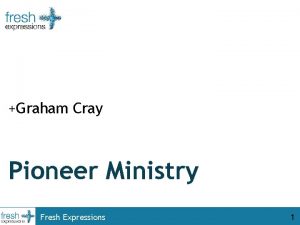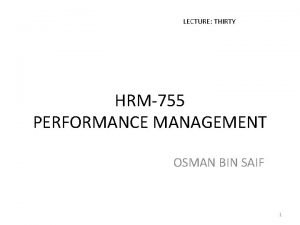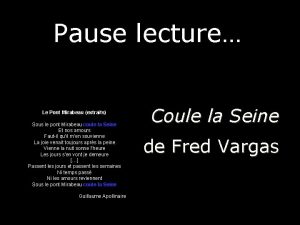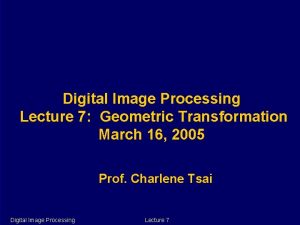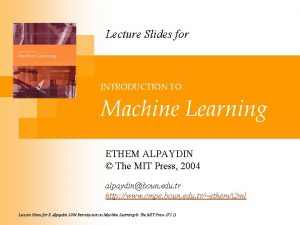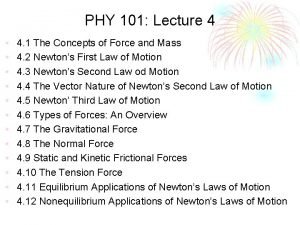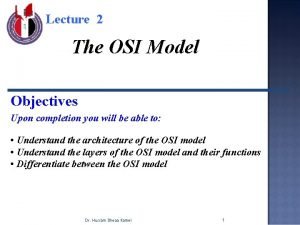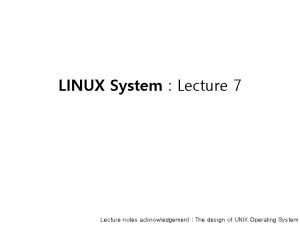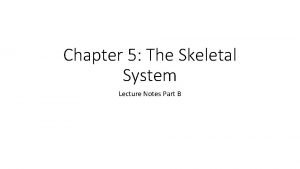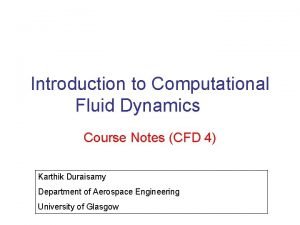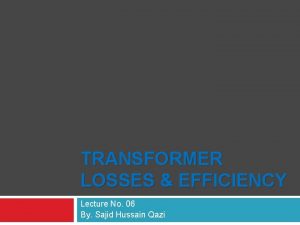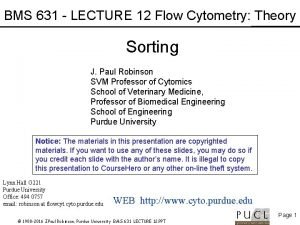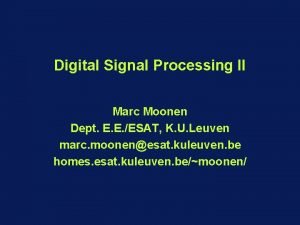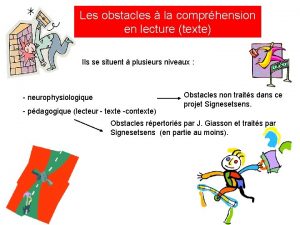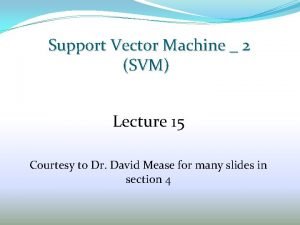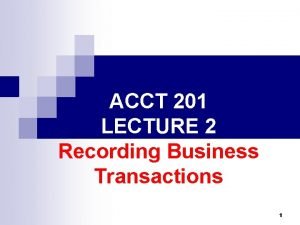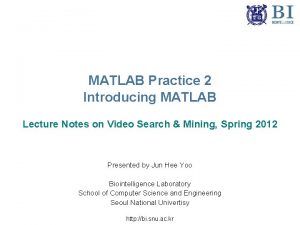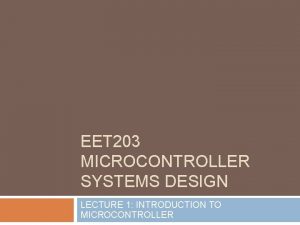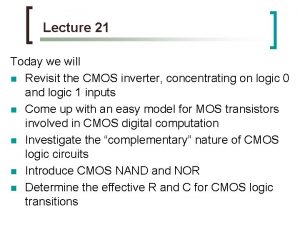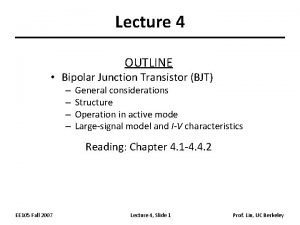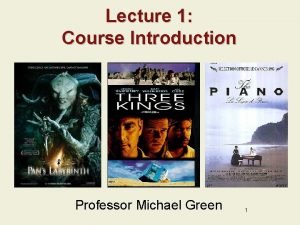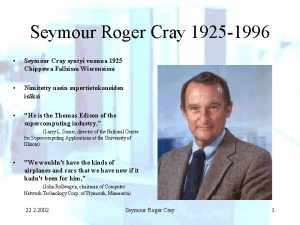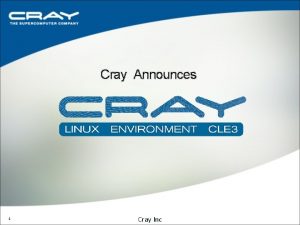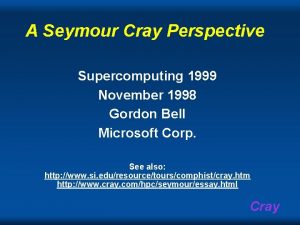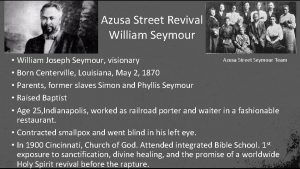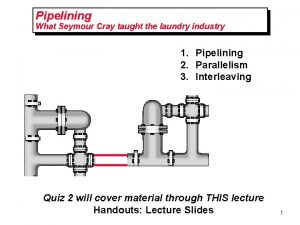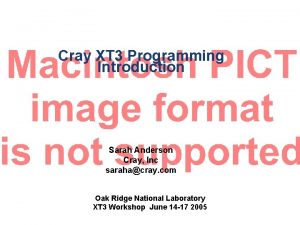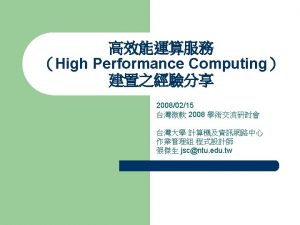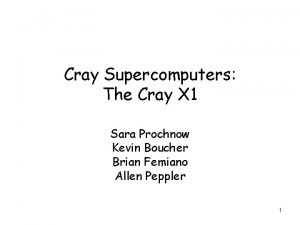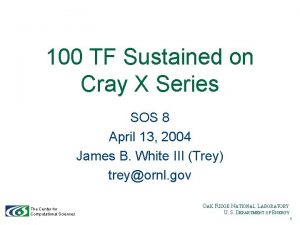A Seymour Cray Perspective Seymour Cray Lecture Series























































































- Slides: 87

A Seymour Cray Perspective Seymour Cray Lecture Series University of Minnesota November 10, 1997 Gordon Bell Cray

Cray 1925 -1996 Cray

Circuits and Packaging, Plumbing (bits and atoms) & Parallelism… plus Programming and Problems n n n Packaging, including heat removal High level bit plumbing… getting the bits from I/O, into memory through a processor and back to memory and to I/O Parallelism Programming: O/S and compiler Cray Problems being solved

Seymour Cray Computers 1951: ERA 1103 control circuits n 1957: Sperry Rand NTDS; to CDC n 1959: Little Character to test transistor ckts n 1960: CDC 1604 (3600, 3800) & 160/160 A n Cray

CDC: The Dawning era of Supercomputers 1964: CDC 6600 (6 xxx series) n 1969: CDC 7600 n Cray

Cray Research Computers 1976: Cray 1. . . (1/M, 1/S, XMP, YMP, C 90, T 90) n 1985: Cray 2 Ga. As… and Cray 3, Cray 4 n Cray

Cray Computer Corp. Computers 1993: Cray Computer Cray 3 n 1998? : SRC Company large scale, shared memory multiprocessor n Cray

Cray contributions Creative and productive during his entire career 1951 -1996. n Creator and un-disputed designer of supers from c 1960 1604 to Cray 1, 1 s, 1 m c 1977… XMP, YMP, C 90, T 90, 2, 3 n Circuits, packaging, and cooling… n “the mini” as a peripheral computer n Cray

Cray Contribution Use I/O computers n Use the main processor and interrupt it for I/O n Use I/O channels aka IBM Channels n Cray

Cray Contributions n n n CDC 6600 functional parallelism leading to RISC… software control Multi-theaded processor (6600 PPUs) Pipelining in the 7600 leading to. . . Vectors: adopted by 10+ companies. Mainstream for technical computing Established the template for vector supercomputer architecture SRC Company use of x 86 micro in 1986 that could lead to largest, sm. P? Cray

Cray attitudes n n n Didn’t go with paging & segmentation because it slowed computation In general, would cut loss and move on when an approach didn’t work… Les Davis is credited with making his designs work and manufacturable Ignored CMOS and microprocessors until SRC Company design Went against conventional wisdom… but this may have been a downfall. Cray

“Cray” Clock speed (Mhz), no. of processors, peak power (Mflops) Cray

Time line of Cray designs and influence control NTDS Mil spec 1957) control circuit packaging, // vector Cray

Univac NTDS for U. S. Navy. Cray’s first computer Cray

NTDS Univac CP 642 c 1957 30 bit word AC, 7 XR 9. 6 usec. add 32 Kw core 60 cu. Ft. , 2300 #, 2. 5 Kw $500, 000 Cray

NTDS logic drawer 2”x 2. 5” cards Cray

Control Data Corporation Little Character circuit test, CDC 1604 Cray

Little Character Circuit test for CDC 160/1604 6 -bit Cray

CDC 1604 n n n n 1960. CDC’s first computer for the technical market. 48 bit word; 2 instructions/word … just like von Neumann proposed 32 Kw core; 2. 2 us access, 6. 4 us cycle 1. 2 us operation time (clock) repeat & search instructions… Used CDC 160 A 12 -bit computer for I/O 2200# +1100# console + tape etc. 45 amp. 208 v, 3 phase for MG set Cray

CDC 1604 module Cray

CDC 1604 module bay Cray

CDC 1604 with console Cray

CDC 160 12 bit word Cray

The CDC 160 influenced DEC PDP-5 (1963), and PDP-8 (1965) 12 -bit word minis Cray

CDC 1604 The classic Accumulator Multiplier. Quotient; 6 B (index) register design. I/O transfers were block transferred via I/O assembly registers Cray

Norris & Mullaney et al Cray

CDC 3600 successor to 1604 Cray

CDC 6600 (and 7600) Cray

CDC 6600 Installation Cray

CDC 6600 operator’s console Cray

CDC 6600 logic gates Cray

CDC 6600 cooling in each bay Cray

CDC 6600 Cordwood module Cray

SDS 920 module 4 flip flops, 1 Mhz clock c 1963 Cray

CDC 6600 modules in rack Cray

CDC 6600 1 Kbit core plane Cray

CDC 1600 & 6600 logic & power densities Cray

CDC 6600 block diagram Cray

CDC 6600 registers Cray

Dave Patterson… who coined the word, RISC “The single person most responsible for supercomputers. Not swayed by conventional wisdom, Cray single-mindedly determined every aspect of a machine to achieve the goal of building the world's fastest computer. Cray was a unique personality who built unique computers. ” Cray

Blaauw -Brooks 6600 comments n n n n Architecturally, the 6600 is a “dirty” machine -- so it is hard to compile efficient code Lack of generality. 15 & 30 bit insts Specialized registers. 3 kinds Lack of instruction symmetry. Incomplete fixed point arithmetic … Too few PPUs Cray

John Mashey, MIPS founder (MIPS first commercial RISC outside of IBM) Seymour Cray is the Kelly Johnson of computing. Growing up not far apart (Wisconsin, Upper Michigan), one built the fastest computers, the other built the fastest airplanes, project after project. Both fought bureaucracy, both led small teams, year after year, in creating aweinspiration technology progress. Both will be remembered for many years. Cray

Thomas Watson, IBM CEO 8/63 “Last week Control Data … announced the 6600 system. I understand that in the laboratory developing the system there are only 34 people including the janitor. Of these, 14 are engineers and 4 are programmers … Contrasting this modest effort with our vast development activities, I fail to understand why we have lost our industry leadership position by letting someone else offer the world’s most powerful Cray computer. ”

Cray’s response: “It seems like Mr. Watson has answered his own question. ” Cray

Effect on IBM: market & technical n n n n 1965: IBM ASC project established with 200 people in Menlo Park to regain the lead 1969 the ASC Project was cancelled. The team was recalled to NY. 190 stayed. The basis of John Cocke’s work on RISC. Amdahl Corp. resulted (plug compatibles and lower priced mainframes, master slice) IBM pre-announced Model 90 to stop CDC from getting orders CDC sued because the 90 was just paper The Justice Dept. issued a consent decree. Cray IBM paid CDC 600 Million +. . .

CDC 6600 n n n n n Fastest computer 10/64 -69 till 7600 intro Packaging for 400, 000 transistors Memory 128 K 60 -bit words; 2 M words ECS 100 ns. (4 phase clock); 1, 000 ns. cycle Functional Parallelism: I/O adapters, I/O channels, Peripheral Processing Units, Load/store units, memory, function units, ECS- Extended Core Storage 10 PPUs and introduced multi-threading 10 Functional units control by scoreboard 8 word instruction stack Cray No paging/segmentation… base & bounds

John Cocke “All round good computer man…” n “When the 6600 was described to me, I saw it as doing in software what we tried to do in hardware with Stretch. ” n Cray

CDC 7600 Cray

CDC 7600 s at Livermore Cray

Butler Lampson I visited Livermore in 1971 and they showed me a 7600. I had just designed a character generator for a high-resolution CRT with 27 ns pixels, which I thought was pretty fast. It was a shock to realize that the 7600 could do a floating-point multiply for every dot that I could display! In 1975 or 1976, when the Cray 1 was introduced, . . . I heard him at Livermore. He said that he had always hated the population count unit, and left it out of the Cray 1. However, a very important customer said that it had to be there, so he put it back. This was the first time I realized that its Cray purpose was cryptanalysis.

CDC 7600 n n n n n Upward compatible with 6600 27. 5 ns clock period (36 Mhz. ) 3360 modules 120 miles of wire 36 Mega(fl)ops PEAK 60 -bit words. Achieved via extensive pipelining of 9 Central processor’s functional units Serial 1 operated 1/69 -10/88 at LLNL 65 Kw Small core. 512 Kw Large core 15 Peripheral Processing Units Cray $5. 1 M

CDC 7600 module slice Cray

CDC 7600 12 bit core module Cray

CDC 7600 block diagram Cray

CDC 7600 registers Cray

CDC 8600 Prototype Cray

Cray Research… Cray 1 n n n Started in 1972, Cray 1 operated in 1974 12 ns. Three ECL I/C types: 2 gates, 16 and 1 K bits 144 ICs on each side of a board; approximately 300 K gates/computer 8 Scalar, 8 Address, 8 Vector (64 w), 64 scalar Temps, 64 address B temps 12 function units 1 Mword memory; 4 clock cycle Scalar speed: 2 x 7600 Cray Vector speed: 80 Mflops

Cray 1 scalar vs vector perf. in clock ticks Cray

CDC 7600 & Cray 1 at Livermore Cray

Cray 1 #6 from LLNL. Located at The Computer Museum History Center, Moffett Field Cray

Cray 1 150 Kw. MG set & heat exchanger Cray

Cray 1 processor block diagram… see 6600 Cray

Steve Wallach, founder Convex “I began working on vector architecture in 1972 for military computers including APL. n “I fell in love with Cray 1. n Continue to value Cray’s Livermore talk – Raised the awareness and need for bandwidth – Kuck & Kennedy work on parallelization and vectorization was critical – n 1984: Convex was founded to build the C-1 mini-supercomputer. Convex followed the Cray formula including m. Ps and Ga. As Cray

Cray XMP 4 vector Proc. Cray

Cray, Cray 2 Proto, & Rollwagen Cray

Cray 2 Cray

Cray Computer Corporation” Cray 3 and Cray 4 Ga. As based computers Cray

Cray 3 c 1995 processor 500 MHz 32 modules 1 K Ga. As ic’s/module 8 proc. Cray

Howard Sachs recollection working in Colorado Springs 1979 - 1982 He was one of the highlights of our industry and I was very lucky to know and work with him. I learned a tremendous amount from him and was very appreciative of the opportunity. We spent most of the time talking about architectures and software. A significant amount of time was spent discussing the depth of pipelining and vector register startup times. His style as the project manager was to ask different people to design sections of the machine. They had little direction and were allowed to have a lot of freedom, . . . Cray

Sachs comments the team couldn't solve the packaging problems to his satisfaction. As a result he told me to fire everyone, and he said he was through with the Cray 2 and was going to work on operating system issues. After 6 months or so Seymour called me, he was very excited, because he had solved the Cray 2 packaging problem and wanted me to see it. We were all very surprised, because we thought he was working on operating systems. The approach was the little pogo pins and vapor phase reflow soldering that ultimately went into production. It was quite novel but did not seem to be manufacturable. Cray

Sachs on Logic Most of us logicians and architects in Boulder all studied the logic for the Cray 1 and found his work to be simple but not obvious. It took a lot of effort to understand some of the features of his logic. Some designs still stick in my mind, his adders were very fast and different, although now the techniques are in all the textbooks and very common. The way he swapped context was quite interesting; the register files were all dual ported so that all the registers could be moving at the same time. Seymour was a great architect, logician, and packaging engineer but did not understand circuit design or semiconductor technology. During the 60's and 70's most of the architects had strong logic design backgrounds. I recall that most of the architects of that time were weak in circuit design and since VLSI was not mature, the architects of the day were generally not experienced with these new capabilities. Cray

Sachs We did discuss LSI with Seymour, bipolar of course; CMOS was much too slow and not interesting till 1984 when 1 micron CMOS became available. Seymour did encourage me to build a bipolar semiconductor pilot line to build chips for prototype computers. . I subsequently went to work for Tom at the Fairchild Research Center where I worked on microprocessor development. There were many discussions about the selling price of the Cray computers, Seymour and John Rollwagen did not want to drop down to 1 million-dollar computers, they wanted to stay at the 10 million range which ultimately destroyed the company (my opinion only). Their customers, the big labs wanted less expensive smaller machines and wanted to experiment with parallel processing at the time. Cray

“ Petaflops by 2010 ” 1994 DOE Accelerated Strategic Computing Initiative (ASCI) Cray

February 1994 Petaflops Workshop n 3 Alternatives for 2014 Each have to deliver 400 Tflops – Shared memory, cross-bar connects 400, 1 Tflops processors! – Distributed, 4, 000 to 40, 000 computers @ 10 to 100 Gflops – PIM 400, 000 computers @ 1 Gflops – n No attention to disks, networking Cray

Cray spoke at Jan. 1994 Petaflops Workshop n n n Cray 4 projected at $80 K/Gflops, $20 K in 1998 sans memory (Mp). 67 cost decr/yr; 41% flops incr/yr 1 Tflops = $20 M processor + $30 M Mp 1 Gflops requires 1 Gwords/sec of BW SIMD $12 M = 2 M x $6/1 -bit processors … in 1998 this is 32 M for 1 Tflops at $50 M Projected a petaflops in 20 years… not 10! Described protein and nanocomputers Cray

SRC Company Computer Cray’s Last Computer c 1996 -98 n n n Uniform memory access across a large processor count. NO memory hierarchy! Full coherency across all processors. Hardware allows for large crossbar SMPs with large processor counts. Programming model is simple and consistent with today’s existing SMPs. Commodity processors soon to be available allow for a high degree of parallelism on chip. Heavily banked, traditional Seymour Cray memory design architecture.

The End Cray

Supercomputing Next Steps Cray

Battle for speed through parallelism and massive parallelism Cray

“ Parallel processing computer architectures will be in use by 1975. ” Navy Delphi Panel 1969 Cray

“ In Dec. 1995 computers with 1, 000 processors will do most of the scientific processing. ” Danny Hillis 1990 bet with Gordon Bell (1 paper or 1 company) Cray

Bell Prize winners 1987 -1997 (transition from ECL to CMOS vector and microprocessors) n Speedup: 2000 X Teraflops n Moore’s law: 100 X 100 Gigaflops n Spend more: 2 X 10 Gigaflops n ECL èCMOS: 10 X Gigaflops ‘ 87 ‘ 89 ‘ 91 ‘ 93 ‘ 95 Cray ‘ 97

“ Is a Petaflops possible? What price? ” Gordon Bell, ACM 1997 Moore’s Law 100 - 450 x But how fast can the clock tick? n Spend more ($100 M è$500 M) 5 x n Centralize centers or fast network n Commoditization (competition) 3 x n 3 x Cray

Is vector processor dead? Ratio of Vector processor to Microprocessor speed vs time 1993 Cray Y-MP IBM RS 6000/550 9. 4 1997 NEC SX-4 SGI R 10 k 9. 02 2000* Fujitsu VPP Intel Merced 9. 00 Cray

Is Vector Processor dead in 1997 for climate modeling? Cray

Cray computers vs time Cray

Jim Gray Seymour built simple machines - he knew that if each step was simple it would be fast. n When asked what kind of CAD tools he used for the CRAY 1 he said that he liked #3 pencils with quadrille pads. He recommended using the back sides of the pages so that the lines were not so dominant. n When he was told that Apple had just bought a Cray to help design the next Mac, Seymour commented that he had just bought a Mac to design the next Cray. n Cray
 Cdc 6600
Cdc 6600 01:640:244 lecture notes - lecture 15: plat, idah, farad
01:640:244 lecture notes - lecture 15: plat, idah, farad Geology lecture series
Geology lecture series Dcac lecture series
Dcac lecture series Mike seymour manchester
Mike seymour manchester Data structure operations
Data structure operations What are the geriatric giants
What are the geriatric giants Donna seymour
Donna seymour Pass and seymour arc fault receptacle
Pass and seymour arc fault receptacle Seymour hoppen
Seymour hoppen Under the bleachers by seymour butz
Under the bleachers by seymour butz Dundee social work
Dundee social work William seymour miracles
William seymour miracles Silo perspective vs business process perspective
Silo perspective vs business process perspective 3 point perspective stairs
3 point perspective stairs Scott cray
Scott cray Which feeding level represents the primary consumers
Which feeding level represents the primary consumers St mary cray primary school
St mary cray primary school Cray 1 supercomputer
Cray 1 supercomputer John levesque cray
John levesque cray St mary cray primary
St mary cray primary Discernment
Discernment Cray 1
Cray 1 Graham cray
Graham cray Taylor series of composite functions
Taylor series of composite functions Maclaurin polynomial
Maclaurin polynomial Series aiding and series opposing
Series aiding and series opposing Maclaurin series vs taylor series
Maclaurin series vs taylor series Ibm p series vs i series
Ibm p series vs i series Arithmetic sum formula
Arithmetic sum formula Balmer series lyman series
Balmer series lyman series Feedback structure
Feedback structure Performance management lecture
Performance management lecture Le pont mirabeau lecture
Le pont mirabeau lecture Catalysis lecture notes
Catalysis lecture notes Divine principle 3 hour lecture
Divine principle 3 hour lecture Euclidean transformation in digital image processing
Euclidean transformation in digital image processing Ethem alpaydin
Ethem alpaydin Phy101 lecture 2
Phy101 lecture 2 Osi model lecture
Osi model lecture Linux lecture notes
Linux lecture notes Mechatronics lecture notes
Mechatronics lecture notes Stanislas dehaene lecture
Stanislas dehaene lecture Ideal diode formula
Ideal diode formula Elements and principles of design ppt
Elements and principles of design ppt Project management lecture notes doc
Project management lecture notes doc Simple harmonic motion lecture
Simple harmonic motion lecture Streak plate method
Streak plate method Introduction to public sector accounting
Introduction to public sector accounting Land use planning lecture notes
Land use planning lecture notes Architecture lecture notes
Architecture lecture notes Hyoid bone lecture
Hyoid bone lecture Ntes cfd
Ntes cfd Petit pays chapitre
Petit pays chapitre Electricity and magnetism lecture notes
Electricity and magnetism lecture notes Transformer lecture
Transformer lecture Sociology lecture
Sociology lecture Flow cytometry lecture
Flow cytometry lecture Human resources department structure
Human resources department structure Lecture pas à pas
Lecture pas à pas Switch mode power supply lecture notes
Switch mode power supply lecture notes In this lecture
In this lecture Physics 102
Physics 102 Lecture handout
Lecture handout Life lecture meaning
Life lecture meaning Chest oblique view
Chest oblique view Collocations examples
Collocations examples Introduction to chromatography
Introduction to chromatography Dsp lecture
Dsp lecture Land use planning '' lecture notes
Land use planning '' lecture notes C programming lecture
C programming lecture Les obstacles de la lecture
Les obstacles de la lecture Education thymique
Education thymique Svm lecture
Svm lecture Which sequence correctly summarizes the accounting process?
Which sequence correctly summarizes the accounting process? Matlab
Matlab Microcontroller system design
Microcontroller system design Lecture 21
Lecture 21 Bjt current equation
Bjt current equation Lecture presentation software
Lecture presentation software Software cost estimation notes
Software cost estimation notes Crisis communication lecture
Crisis communication lecture Atmospheric physics lecture notes
Atmospheric physics lecture notes Types of greetings
Types of greetings At the end of the lecture
At the end of the lecture What is this
What is this Aronautique
Aronautique Knots si unit
Knots si unit
